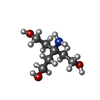[English] 日本語
 Yorodumi
Yorodumi- PDB-4czb: Structure of the sodium proton antiporter MjNhaP1 from Methanocal... -
+ Open data
Open data
- Basic information
Basic information
| Entry | Database: PDB / ID: 4czb | ||||||
|---|---|---|---|---|---|---|---|
| Title | Structure of the sodium proton antiporter MjNhaP1 from Methanocaldococcus jannaschii at pH 8. | ||||||
 Components Components | (NA(+)/H(+) ANTIPORTER 1) x 2 | ||||||
 Keywords Keywords | MEMBRANE PROTEIN / ANTIPORTER / TRANSPORTER / EXCHANGER / CPA | ||||||
| Function / homology |  Function and homology information Function and homology informationpotassium:proton antiporter activity / sodium ion transport / intracellular potassium ion homeostasis / identical protein binding / plasma membrane Similarity search - Function | ||||||
| Biological species |   METHANOCALDOCOCCUS JANNASCHII (archaea) METHANOCALDOCOCCUS JANNASCHII (archaea) | ||||||
| Method |  X-RAY DIFFRACTION / X-RAY DIFFRACTION /  SYNCHROTRON / SYNCHROTRON /  MOLECULAR REPLACEMENT / Resolution: 3.5 Å MOLECULAR REPLACEMENT / Resolution: 3.5 Å | ||||||
 Authors Authors | Woehlert, D. / Paulino, C. / Kapotova, E. / Kuhlbrandt, W. / Yildiz, O. | ||||||
 Citation Citation |  Journal: Elife / Year: 2014 Journal: Elife / Year: 2014Title: Structure and transport mechanism of the sodium/proton antiporter MjNhaP1. Authors: Cristina Paulino / David Wöhlert / Ekaterina Kapotova / Özkan Yildiz / Werner Kühlbrandt /  Abstract: Sodium/proton antiporters are essential for sodium and pH homeostasis and play a major role in human health and disease. We determined the structures of the archaeal sodium/proton antiporter MjNhaP1 ...Sodium/proton antiporters are essential for sodium and pH homeostasis and play a major role in human health and disease. We determined the structures of the archaeal sodium/proton antiporter MjNhaP1 in two complementary states. The inward-open state was obtained by x-ray crystallography in the presence of sodium at pH 8, where the transporter is highly active. The outward-open state was obtained by electron crystallography without sodium at pH 4, where MjNhaP1 is inactive. Comparison of both structures reveals a 7° tilt of the 6 helix bundle. (22)Na(+) uptake measurements indicate non-cooperative transport with an activity maximum at pH 7.5. We conclude that binding of a Na(+) ion from the outside induces helix movements that close the extracellular cavity, open the cytoplasmic funnel, and result in a ∼5 Å vertical relocation of the ion binding site to release the substrate ion into the cytoplasm. | ||||||
| History |
|
- Structure visualization
Structure visualization
| Structure viewer | Molecule:  Molmil Molmil Jmol/JSmol Jmol/JSmol |
|---|
- Downloads & links
Downloads & links
- Download
Download
| PDBx/mmCIF format |  4czb.cif.gz 4czb.cif.gz | 312.3 KB | Display |  PDBx/mmCIF format PDBx/mmCIF format |
|---|---|---|---|---|
| PDB format |  pdb4czb.ent.gz pdb4czb.ent.gz | 256.1 KB | Display |  PDB format PDB format |
| PDBx/mmJSON format |  4czb.json.gz 4czb.json.gz | Tree view |  PDBx/mmJSON format PDBx/mmJSON format | |
| Others |  Other downloads Other downloads |
-Validation report
| Summary document |  4czb_validation.pdf.gz 4czb_validation.pdf.gz | 473 KB | Display |  wwPDB validaton report wwPDB validaton report |
|---|---|---|---|---|
| Full document |  4czb_full_validation.pdf.gz 4czb_full_validation.pdf.gz | 497 KB | Display | |
| Data in XML |  4czb_validation.xml.gz 4czb_validation.xml.gz | 55.4 KB | Display | |
| Data in CIF |  4czb_validation.cif.gz 4czb_validation.cif.gz | 73.7 KB | Display | |
| Arichive directory |  https://data.pdbj.org/pub/pdb/validation_reports/cz/4czb https://data.pdbj.org/pub/pdb/validation_reports/cz/4czb ftp://data.pdbj.org/pub/pdb/validation_reports/cz/4czb ftp://data.pdbj.org/pub/pdb/validation_reports/cz/4czb | HTTPS FTP |
-Related structure data
| Related structure data |  2636C  4d0aC 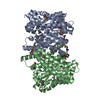 4cz8S S: Starting model for refinement C: citing same article ( |
|---|---|
| Similar structure data |
- Links
Links
- Assembly
Assembly
| Deposited unit | 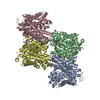
| ||||||||
|---|---|---|---|---|---|---|---|---|---|
| 1 | 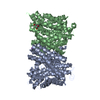
| ||||||||
| 2 | 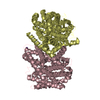
| ||||||||
| Unit cell |
|
- Components
Components
| #1: Protein | Mass: 45998.891 Da / Num. of mol.: 3 / Fragment: TRANSPORTER DOMAIN, RESIDUES 1-426 Source method: isolated from a genetically manipulated source Source: (gene. exp.)   METHANOCALDOCOCCUS JANNASCHII (archaea) METHANOCALDOCOCCUS JANNASCHII (archaea)Production host:  #2: Protein | | Mass: 46012.918 Da / Num. of mol.: 1 / Fragment: TRANSPORTER DOMAIN, RESIDUES 1-426 Source method: isolated from a genetically manipulated source Source: (gene. exp.)   METHANOCALDOCOCCUS JANNASCHII (archaea) METHANOCALDOCOCCUS JANNASCHII (archaea)Production host:  #3: Chemical | #4: Chemical | ChemComp-TAM / | |
|---|
-Experimental details
-Experiment
| Experiment | Method:  X-RAY DIFFRACTION / Number of used crystals: 1 X-RAY DIFFRACTION / Number of used crystals: 1 |
|---|
- Sample preparation
Sample preparation
| Crystal | Density Matthews: 3.49 Å3/Da / Density % sol: 61 % / Description: NONE |
|---|---|
| Crystal grow | pH: 8.2 / Details: pH 8.2 |
-Data collection
| Diffraction | Mean temperature: 100 K |
|---|---|
| Diffraction source | Source:  SYNCHROTRON / Site: SYNCHROTRON / Site:  ESRF ESRF  / Beamline: ID23-1 / Wavelength: 0.9763 / Beamline: ID23-1 / Wavelength: 0.9763 |
| Detector | Date: Jul 13, 2012 |
| Radiation | Protocol: SINGLE WAVELENGTH / Monochromatic (M) / Laue (L): M / Scattering type: x-ray |
| Radiation wavelength | Wavelength: 0.9763 Å / Relative weight: 1 |
| Reflection | Resolution: 3.5→32 Å / Num. obs: 58249 / % possible obs: 99.3 % / Observed criterion σ(I): 1.7 / Redundancy: 7 % / Rmerge(I) obs: 0.09 / Net I/σ(I): 6 |
| Reflection shell | Resolution: 3.5→3.72 Å / Redundancy: 7.2 % / Rmerge(I) obs: 0.57 / Mean I/σ(I) obs: 1.7 / % possible all: 99.2 |
- Processing
Processing
| Software |
| ||||||||||||||||
|---|---|---|---|---|---|---|---|---|---|---|---|---|---|---|---|---|---|
| Refinement | Method to determine structure:  MOLECULAR REPLACEMENT MOLECULAR REPLACEMENTStarting model: PDB ENTRY 4CZ8 Resolution: 3.5→32 Å / σ(F): 6
| ||||||||||||||||
| Solvent computation | Shrinkage radii: 0.9 Å / VDW probe radii: 1.11 Å / Solvent model: FLAT BULK SOLVENT MODEL | ||||||||||||||||
| Refinement step | Cycle: LAST / Resolution: 3.5→32 Å
|
 Movie
Movie Controller
Controller


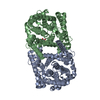
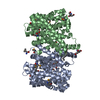
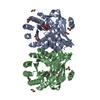
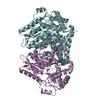
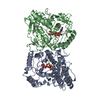

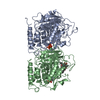
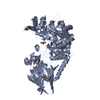


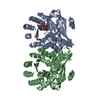

 PDBj
PDBj

